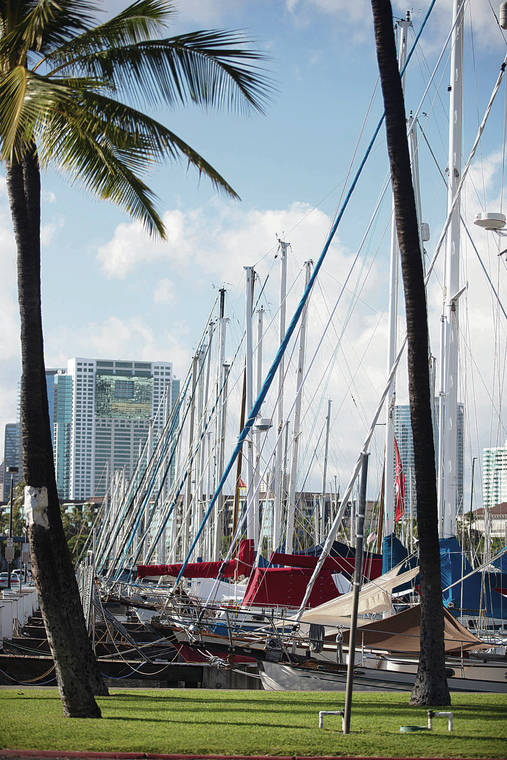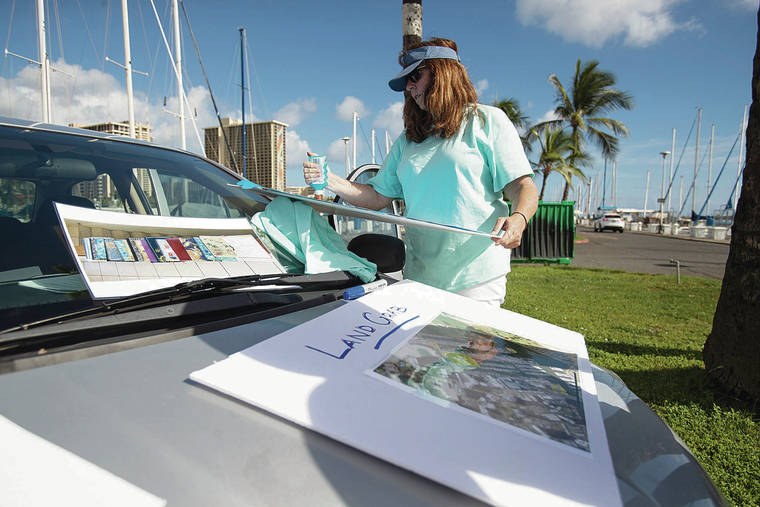A 100% jump in boat slip fees beginning Nov. 1 at the Ala Wai Small Boat Harbor is a way to push out the average kamaaina renter and a step
toward privatizing it, limiting public access, a group of renters say.
That will affect everyone who uses the public harbor, from surfers, paddlers and bodyboarders to families who tailgate on Friday nights to watch the fireworks, they say.
The state also has advertised amenities at the Ala Wai that haven’t existed for
10 years, which are “put up to privatize the harbor,” said James Callahan, 39, who rents a slip and lives on his sailboat at the Ala Wai.
“That’s the strategy that (Division of Boating and Ocean Recreation Administrator) Ed Underwood has, not only here, but all over the state.”
Mooring fees across the state are increasing, but the Ala Wai’s is going up the most, and the rates are based on catwalk and boat length, both of which can be measured in different ways.
Many cite mismanagement as a major issue. If all 699 berths were rented out, there would be no need to raise the rent, they say. But they estimate about 100 to 150 are unrented every month, with half
in good condition and the other half dilapidated and unusable.
DOBOR, they say, piled up dilapidated boats onto an old boat, which sank and polluted the harbor.
The renters at the public boat harbor say the average person — many of whom are retired — may not be able to afford the increase, and it’s being done to make way for private companies to bid on four parcels, including submerged lands, designated for lease by DOBOR.
The group rallied Friday to protest the increases. They say the “public-private partnership” that Underwood says is a model in his “Modernizing and Revitalizing Ocean Recreation Management in Hawaii, Strategic Action Plan 2019” actually means private and that Kewalo Basin is a model for it.
Less public access is what can be expected, they say, pointing to restrictions
at private harbors such as Ko Olina Marina and Keehi Marine Center Marina.
Kate Thompson, who organized the rally, shared Underwood’s written response to questions she had.
He told her, “We have been more than fair to the Boaters given the fact that the previous fee increase was not fully implemented and the Legislature wanted this increase to go into effect in 2014. Boaters have had a five-year grace period and ample time to plan ahead.”
If people no longer can
afford a large slip, they cannot relocate into a smaller slip unless they can show the vessel will fit without substantially altering the vessel’s design, he said.
In the email, Underwood says DOBOR will be charging based on either maximum length of dock
or vessel, whichever is greater.
Thompson wrote Underwood, saying, “We have endured the hardship of no fuel dock and no haul-out
facility for 10 years.”
He said they were not
financially viable to operate, and “the haul-out could not obtain the required Department of Health permits,” and alleged most vessels “don’t get underway maybe once a year.”
That riled many.
Thompson, 61, a semiretired nurse, bought a sailboat 20 years ago with a group of friends. But some moved and she bought them out.
She has taken 92 people so far this year out on her boat for free to “share the joy of sailing.”
She planned to keep her boat five more years, but with the hike in fees, she probably will sell it in a year or so.
David Hoe, 69, who in 1988 bought a Chinese junk from Hong Kong for cultural purposes and lives on it, says it is 65 feet long measured one way and 72 feet measured another way.
Hoe, who is semiretired, pays $1,000 a month in mooring fees but guesses it will double.
“My opinion is whatever they want to do is what they’re going to end up
doing,” Hoe says.






